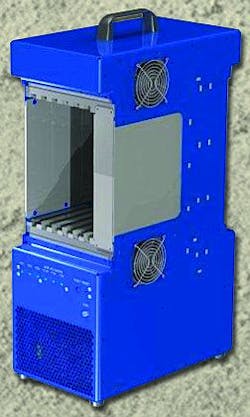Portable six-slot 6U OpenVPX chassis for high-power embedded systems development introduced by Curtiss-Wright
ASHBURN, Va., 17 June 2012.Curtiss-Wright Controls Defense Solutions in Ashburn, Va., is introducing the portable COOL-CC6 six-slot high-power 6U OpenVPX chassis to help systems designers put together OpenVPX, VPX REDI, and VPX embedded computing for military embedded systems and similar severe-environment applications.
The COOL-CC6 6U VPXembedded computing chassis is part of the Curtiss-Wright Hybricon family of chassis. The forced-air, conduction-cooled enclosure fits as many as six slots of 6U 1-inch pitch conduction-cooled OpenVPX cards and rear transition modules.
The chassis COOL-CC6 meets ANSI/VITA 65 power and cooling requirements for conduction-cooled 150-Watt 6U OpenVPX modules, and supports ANSI/VITA 46.0, ANSI/VITA 46.10, ANSI/VITA 48.0, ANSI/VITA 48.2 and ANSI/ VITA 65 OpenVPX specifications.
The COOL-CC6 chassis has a 160-millimeter card cage and top-carrying handle, and supports five- and six-slot OpenVPX backplanes, as well as 80-millimeter rear transition module card cage per ANSI/VITA 46.10 and IEEE 1101.11.
Story continues below
Related stories
Curtiss-Wright Controls Defense Solutions releases dual LED backlit version of AVDU-2655 Multi-Function Display for NVG applications
Curtiss-Wright Controls Defense Solutions introduces rugged video switching, recording & distribution solution
Curtiss-Wright Controls introduces the Cool-CC3 3U VPX conduction-cooled chassis.
The chassis's fans and advanced cooling design provide a less than 55-degree Celsius chassis conduction rail temperature at 30 C, per ANSI/VITA 65 OpenVPX standard. The chassis also offers low acoustic noise from its built-in fan speed control.
For more information contact Curtiss-Wright Controls Defense Solutions online at www.cwcdefense.com.
Follow Military & Aerospace Electronics and Avionics Intelligence news updates on Twitter

